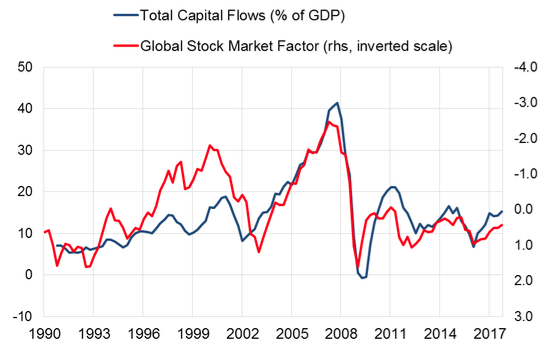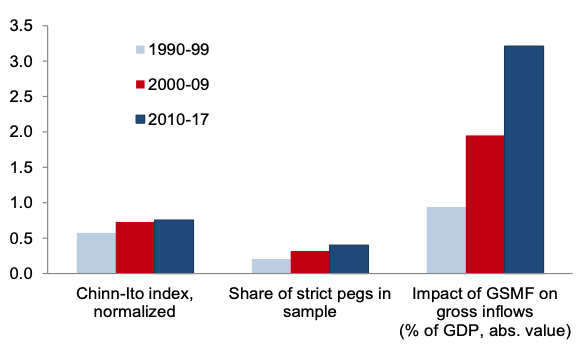Apparently, international financial integration has generated a global financial cycle, leading to increasing cross-country co-movement of financial variables – either flows or prices (Rey 2015). But a global financial cycle strongly challenges one of the cornerstones of international macroeconomics, namely, the policy trilemma which suggests a trade-off between an independent monetary policy and an exchange rate target under full capital account liberalisation.
A global financial cycle would significantly reduce the ability of policymakers to steer domestic financial conditions away from global trends, for instance by adopting flexible exchange rate regimes and running a monetary policy independent from that of the US, which sets global monetary conditions. The global financial cycle would reduce the trilemma to a dilemma – policy choice would be solely between an independent monetary policy and capital account openness. The exchange rate regime would become irrelevant (Rey 2015, 2016).
Others maintain that a flexible exchange rate regime still allows for a higher degree of monetary autonomy (Klein and Shambaugh 2015), and so they challenge the concept of a dilemma. Our recent research (Habib and Vendetti 2019) offers three important insights:
- We confirm that for capital flows a global cycle is intimately connected to global risk.
- We investigate the drivers of global risk.
- We show the extent to which domestic policies may partly stem the tide of capital flows at the country level.
The global capital flows cycle and global risk
The global financial cycle is strongly influenced by US monetary policy and related to both financial market volatility and to the degree of risk aversion of global investors (Miranda-Agrippino and Rey 2015). Our Global Stock Market Factor – a data-parsimonious version of the global factor of Miranda-Agrippino and Rey (2015) that summarises the co-movement of stock market returns in 63 economies – is tightly connected to a cycle in global capital flows, as measured by the sum of gross capital inflows across 50 advanced and emerging economies (Figure 1). The correlation between the two series is remarkably tight (75%). To our knowledge, it is extremely difficult to find empirical studies that find such a close link between measures derived from prices (as our Global Stock Market Factor) and those derived from cross-border capital flows.
Figure 1 Global capital flows are tightly connected to global risk
Notes: Total capital gross inflows aggregated across 50 economies as share of total GDP. The Global Stock Market Factor is constructed from stock returns for 63 countries.
Sources: IMF Balance of Payments Statistics, Global Financial Data and authors’ calculations.
The drivers of global risk: Not only US monetary policy
The second important pillar of the theory of the global financial cycle is the role of the US, the centre country in the international monetary system, in influencing global risk and shaping financial conditions globally (Bruno and Shin 2015). In our analysis, we did not find that the US monetary policy has a robust and significant direct impact on capital flows. We did find that that US monetary policy may have an effect on capital flows indirectly, influencing global risk.
In particular, we investigated the structural drivers of our Global Stock Market Factor and identified four shocks that should be expected to impact global risk:
- a US monetary policy shock,
- a US aggregate demand shock,
- a global financial shock, and
- a geopolitical risk shock.
As shown in Figure 2, financial shocks, which can be interpreted as exogenous changes in the risk-bearing capacity of the financial sector, matter slightly more than US monetary policy shocks in driving global risk. Other shocks, such as those driven by geopolitical or economic policy uncertainty or by the US demand are not particularly relevant. Notably, global risk still includes a significant idiosyncratic component that is not explained by our shocks.
Figure 2 Financial shocks and US monetary policy drive global risk
Notes: forecast error variance decomposition (12 steps ahead) of the Global Stock Market Factor: average across posterior draws of the model.
Source: authors’ calculations
The transmission of global risk to capital flows
Finally, we studied how capital account openness and the exchange rate regime influence the transmission of global risk to different types of capital flows. Remarkably, we found confirmation of a trilemma in the transmission to capital flows, as countries that are more financially open, and that adopt a strict peg, are more sensitive to global risk. This trilemma is largely driven by one category of cross-border flows – 'other investment'. This is largely made up of bank loans, confirming the importance of global banks in the narrative of the global financial cycle. In particular, for emerging markets with open capital accounts and an exchange rate target, global risk shocks may impart a significant shift in capital flows compared to normal times. To get a glimpse of the economic impact, a sharp rise in global risk – for example, a two standard deviation shock to our risk measure – would translate into a decline in gross capital inflows of 1% of GDP in a quarter for emerging markets, but a decline of more than 4% of GDP for those emerging economies without capital controls that adopt a fixed exchange rate regime.
Reconciling the global capital flows cycle with the trilemma
Is there a contradiction between the tight link between our Global Stock Market Factor and global capital inflows, lending support to the presence of a policy dilemma (Rey 2015), and the evidence of a classical trilemma? Not necessarily, as the policy regimes may change through time, reinforcing or weakening the link between global risk and capital flows. Figure 3 shows the average level of de jure capital account liberalisation and the share of countries adopting a strict peg in our sample in the 1990s, the 2000s, and since 2010.
Figure 3 Policy regimes and sensitivity of total gross capital inflows to the global stock market factor (GSMF) since the 1990s
Notes: the normalised Chinn-Ito (2006) index is a measure of de jure capital account openness ranging between 0 (completely closed) and 1 (fully open). Strict pegs are defined according to the de facto exchange rate arrangement classification by Obstfeld et al. (2010). The last three columns report the absolute value of the coefficient associated with the Global Stock Market Factor (GSMF) in the benchmark panel fixed-effects model for total capital inflows, estimated across the three sub-samples.
Both measures tend to increase over time. The higher these two measures, the stronger the expected sensitivity of capital flows to global risk according to the trilemma. Indeed, this is exactly what we find once we re-estimate the impact of global risk on capital flows in our empirical model across these three decades.
Concluding remarks
There are interesting implications for the future analysis of international macroeconomic models and the international transmission of monetary and financial shocks.
First, it is important to isolate the contribution of US monetary policy shocks to global risk to understand its international transmission. It may be difficult to establish a direct link between US monetary policy and capital flows, without 'passing through' global risk. Nevertheless, global risk is also driven by other shocks, in particular financial shocks, and has a large idiosyncratic component, so that US monetary policy may be considered neither as the unique nor as the main factor behind the influence of the global financial cycle on capital flows.
Second, domestic monetary and exchange rate policies may still influence the transmission of global risk to capital flows, especially cross-border bank loans. On the contrary, portfolio flows appear to be less sensitive to global risk and completely insensitive to the prevailing exchange rate regime, because the adjustment to risk shocks, most likely, takes places through prices and not quantities.
Our results call for a careful assessment of the financial stability implications of global risk shocks. As the composition of global liquidity shifts away from bank loans to other sources of financing, such as equity and bonds, sudden shifts in investors' risk attitude could propagate faster than in the past, through sharp fluctuations in market prices rather than capital flows.
Authors’ note: The views expressed in this column belong to the authors and do not necessarily represent the views of the ECB.
References
Bruno, V and H S Shin (2015), “Capital flows and the risk-taking channel of monetary policy", Journal of Monetary Economics 71: 119 -132.
Habib, M M and F Venditti (2019), “The global capital flows cycle: structural drivers and transmission channels”, ECB working paper 2280.
Klein, M W and J C Shambaugh (2015), “Rounding the corners of the policy trilemma: sources of monetary policy autonomy”, American Economic Journal: Macroeconomics 7: 33-66.
Miranda-Agrippino, S and H Rey (2015), “US Monetary Policy and the Global Financial Cycle”, NBER working paper 21722.
Rey, H (2015), “Dilemma not Trilemma: The Global Financial Cycle and Monetary Policy Independence”, NBER working paper 21162.
Rey, H (2016), “International channels of transmission of monetary policy and the Mundellian trilemma”, IMF Economic Review 64: 6-35.






